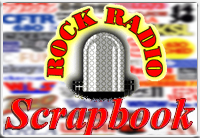
Airchecks: 1981
Talent: DADDY COOL
Station: CFNY
Brampton, Ont.
Date: Winter
1981-82
Time: 5:59
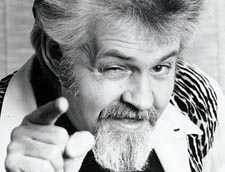
His real name was Dave Booth, but to his legion of fans he was Daddy Cool, the Daddio of the Radio!
Born in 1940 in Yorkshire, England, Booth moved to Canada in 1960. He started in radio in 1963 when he agreed to do janitorial work at Kitchener station CKCR (now known as CHYM) in exchange for an on-air shift on Sunday nights. The show was called "Big D with R&B." He left the station when he asked to get paid, but returned in 1971 with a show called "Kaleidoscope." It was on that show Booth created his Daddy Cool character (for the first part of his program he'd be Dave Booth; for the last hour - all blues - he'd be Daddy Cool.

Booth left the station for a stay of more than a decade at Toronto station CFNY. He called his 9 p.m.-1 a.m. show "Daddy Cool's Bluestime," but quit in 1988 after being told to play music from a playlist. Booth resurfaced in 2018 with a weekly show called "Dave's Jukebox" at WhiStle radio (CIWS) in Stouffville, Ontario, but he has since retired from the airwaves.
During his long career in music, Booth has assembled a collection of over 10,000 vinyl records and another 135,000 on his computer. He has been promotional manager for groups like Battered Wives and Bob Segarini and has managed Bop Cats and the Stray Cats. Booth has also done a series of R&B compilations called Blowing the Fuse, which won a best vintage release of the year award in Germany.
Enjoy Daddy Cool here. ![]()
(The Tim Sykes Collection)
Subject: SUNDAY
SUNDAY
Station: CFTR
Toronto
Dates: Various
Times: Various
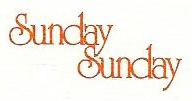
(Logo courtesy Dan Haber)
When we think of Top 40 radio, we tend to focus on the music programming. But back in the day, Top 40 stations had a strong news and sports staffs, and took their public service programming seriously. Case in point: CFTR's acclaimed show "Sunday Sunday."
"Sunday Sunday" was the brainchild of veteran broadcaster Clint Nickerson and CFTR news director Robert Holiday. The show was the successor to "Time Frame", the documentary-like hour-long program carried on CFTR only. "Sunday Sunday" ran from January 1980 to February 14, 1982. It was, in the words of contributor Dan Haber, "a bold experiment and there have been few things like it before or since in the realm of private radio. Ultimately, it was just too expensive to produce and eventually was cancelled."
"Sunday Sunday" was before satellite and each show had to be done by mid-week so tapes could be sent via to stations across Canada for weekend broadcast. At one point, the show aired on 52 stations in 48 markets across the country.
The show was normally hosted by Holiday, though Nickerson took over in the final days. Bev Bowman sometimes co-hosted. The program featured weekly contributions from 'TR newsroom regulars like John Wilson, Bev Bowman, Melanie Reffes and of course the main producer, the late Clint Nickerson. Other 680 types also were expected to play an occasional role and names like Corey Galbraith, Roger Ward, Dana Lewis, Arlene Bynon and Ben Steinfeld did a few bits.
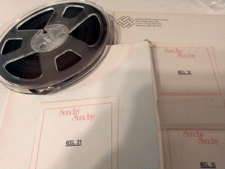
(Picture courtesy Dan Haber)
We have five"Sunday Sunday" segments for you, with descriptions by Dan Haber:
- Mel Blanc is a broadcasting legend. If you’re not familiar with the name, you certainly know the voice. Blanc was the actor behind dozens, if not hundreds, of the most famous cartoon characters in history, including Bugs Bunny, Daffy Duck, Yosemite Sam, Tweety Bird, Barney Rubble and too many more to list. He also did characters and sound effects for Jack Benny for decades on radio and TV. When I called him way back in the 80s, I thought I might coax him to do a voice or two for me. I was overjoyed when he did just about everything I asked for. Plus, I came away from it with one of my most prized possessions – the original voice of Bugs Bunny saying, “Eh, what’s up Dan?” Blanc was a genius and to this day, no one has been able to replace him. I’m grateful I had the chance to talk to him and that's why this is one of my all-time favourite interviews.
- Melanie Reffes' story on Steve Karman is a gem. He's the jingle writer who created dozens of famous commercial classics, including "When you say Budweiser, you've said all," "Sooner or later, you'll own General," "At Beneficial you're good for more," and his most famous, "I Love New York." Just to name a few. All of them and more are featured in the piece, with their composer musing on how he came up with them.
- The Ed Sullivan piece, featuring the author of a book on the show called "A Thousand Sundays" is one of the rare items voiced by Robert Holiday and is based on my interview with the author. What I like best about it is that Sullivan's people refused to let us use any clips from his show without charging us outrageous rates, but I found a way to make it work without them.
- John Wilson's story on Rock Lyrics has lotsa music and lots of slick editing. It took us days and days to put it together.
- And I went to New York to interview the now late Sid Bernstein. If the name isn't familiar, his enterprise will never be forgotten. He's the promoter who brought the Beatles to the U.S. and impressed Brian Epstein by insisting he'd play them at Carnegie Hall. His stories remain entertaining all these years later, even if he was mostly wrong about his latest discovery, Laura Branigan.
Dan Haber adds, "For a year and a bit, the staff was flying all over the world to do radio that only the CBC was capable of offering. Our difference was we did the show with a rock and roll news sense and a highly produced style (courtesy of yours truly!)"
Enjoy the Mel Blanc segment from
September 2, 1980 here. ![]() (9:37)
(9:37)
Enjoy the Steve Karman segment
from November 23, 1980 here. ![]() (9:37)
(9:37)
Enjoy the Ed Sullivan segment from
February 8, 1981 here. ![]() (15:32)
(15:32)
Enjoy the Rock Lyrics segment from
April 6, 1981 here. ![]() (14:57)
(14:57)
Enjoy the Sid Bernstein segment from
May 17, 1981 here. ![]() (12:47)
(12:47)
(The Dan Haber Collection)
Talent: ANDY NEILL
Station: CKFH Toronto
Date: January 2, 1981
Time: 50:56 (unscoped)

Like the subject in the Hank Snow song, Andy Neill has been everywhere.
The veteran broadcaster has entertained at nearly two dozen stations in a career that began in 1963 at CKMR Newcastle, New Brunswick. Neill's radio resume includes CFNB Fredericton, CFOX and CKGM Montreal, CJCH Halifax, CKSL London, Ontario, and CKFH, CJCL, CFTR, CJEZ and CKEY Toronto.
This aircheck captures the end of an era. In January 1981, the CKFH call letters were about to be retired after three decades. CKFH became CJCL April 21, 1981 following the sale of the station to Telemedia by Foster Hewitt, whose health was failing. The legendary hockey broadcaster had owned CKFH since its inception in 1951. Hewitt died in 1985.
Enjoy Andy Neill on CKFH from
January 2, 1981 here. ![]()
(The Tom Tass Collection)
|
Talent: BENOIT
DUFRESNE
Station: CHOM
Montreal
Date: February
13, 1981
Time: 47:40 (unscoped)
4:20 (scoped)

Benoit Dufresne's radio career is mostly a tale of two cities, and two stations.
Dufresne spent 10 years at CHOM Montreal, beginning in 1978 as an on-air host doing various shifts. He was music director from 1982 to his departure in 1988. During his last five years at the station, Dufresne he was host of the New Music Foundation, a weekly three-hour alternative music program. He also co-hosted Rock 'n' Roll News, a 30-minute weekday show.
In 1989, Dufresne moved to Rock 101 CFMI Vancouver as music director and assistant program director. He left the station in 1998 and since then has lived in Burnaby, B.C., working primarily as a translator, writer and voice-over artist.
Dufresne reflected on his CHOM years in a 2013 interview with Michael Williams of Cashbox Canada. "The first 2 years I worked there it was still freeform so the announcers picked their own music. It was magical times," Dufresne told Williams. "Then radio started to be compartmentalized. Specialized formats took over. Less diversity of music and less opinions. But CHOM FM was also great in the 1980s when the station had a formidable CRTC requirement to create a significant number of hours of specialty programming. That’s how I ended up doing a program called the New Music Foundation from 1983 to 1989."
Hear Benoit Dufresne on CHOM (UNSCOPED) here. ![]()
Hear Benoit Dufresne on CHOM (SCOPED) here. ![]()

(The Paul Harner Collection)
Talent: HARRY HARRISON
Station: WCBS-FM New York
Date: February, 1981
Time: 5:25
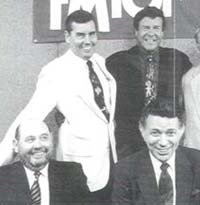
(Clockwise, top left: Harry Harrison, Cousin Brucie, Dan Ingram, Ron Lundy)
It was New York radio's version of the "Million Dollar Quartet."
For a time, the New York station boasted not one but four bonafide legends from WCBS-FM's Musicradio days. Harry Harrison took over the WCBS-FM morning show March 24, 1981, just four months after his 12-year run in WABC's AM drive spot ended. Ron Lundy, the long-time WABC mid-morning jock, started in the same time slot at WCBS-FM on May 14, 1984.
The next WABC legend to join was Cousin Brucie, who started doing a Wednesday night show on August 11, 1985. The Cuz had been the evening jock on WABC from 1961 to 1974. Then former WABC afternoon driver Dan Ingram made it a quartet October 19, 1991 when he joined for weekend duty.
Lundy was the first of the four to leave, retiring with a great send-off September 18, 1997 (he died in 2010). Ingram and Harrison left in 2003 (Harrison returned for weekends in 2004 and '05) and Ingram died in 2018. Brucie departed with WCBS-FM's switch to the Jack format in 2005 and went to Sirius radio the same year. He has since returned to WABC on Saturday nights.
Enjoy Harry Harrison on WCBS-FM from
February, 1981 here. ![]()
(The Bill Dulmage Collection)
Talent: LARRY NORTON
Station: WGRQ Buffalo, N.Y.
Date: April 8, 1981
Time: 19:15 (unscoped)
8:09
(scoped)
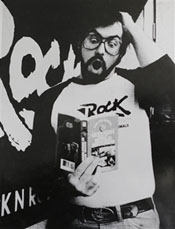
Stunts and contests were a mainstay of Top 40 broadcasting, with stay-awake marathons among the most popular. Peter Tripp did a 206-hour marathon for WMGM in 1958 (supposedly it affected his health in the long term). But on March 14, 1981, Larry "Snortin'" Norton - then the midday jock at Buffalo's 97 Rock WGRQ) - set out to stay on the air for 484 consecutive hours. Under the rules set by the Guinness Book of World Records, Norton could take a five-minute break every hour, or save up those breaks and take a two-hour rest every day. That's what he did, sleeping from 2-4 a.m. and broadcasting for 22 consecutive hours for 20 straight days before finishing up on April 8. When it was over, Norton got a well-deserved trip to the Virgin Islands and yes, some sleep.

(Logo courtesy Bill Dulmage)
To hear how Larry Norton's marathon
ended, click here. (UNSCOPED) ![]()
To hear how Larry Norton's marathon
ended, click here. (SCOPED) ![]()
(Scrapbook archives)
Talent: JOHN MAJHOR
Station: CHUM
Toronto
Date: April, 1981
Time: 8:37
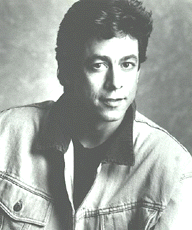
Whether behind the mike, in the lens of a TV camera or in cyberspace, John Majhor was always on the cutting edge of the electronic media.
The San Bernadino, California, native first came to the attention of Toronto radio fans in 1975, as a deejay at 1050 CHUM. For the better part of 11 years, Majhor enjoyed killer ratings with his energetic show at Canada's legendary Top 40 station.
In 1983, Majhor broke new ground in television with Video Singles, a daily 4 p.m. music video show that pre-dated Much Music and earned an astounding 23 rating. That led to another popular video show, Toronto Rocks, on CITY-TV.
After a stop in the much-desired CHUM morning show in 1985-86, Majhor headed west for a groundbreaking talk and country music show at KLAC Los Angeles. That was followed by gigs on the widely-syndicated After Hours TV show and a role as anchor and producer on the newly-launched E! Television. Then it was back to radio as a deejay at KCBS-FM alongside legends such as Charlie Tuna and The Real Don Steele.
In 1990, Majhor returned to Toronto for the morning show at CJEZ-FM followed by a talk show at CFRB and two-year run as host of the popular Lunch Television at CITY-TV. He was also the promo voice for 680 News from 1993 to 1999.
After a year at Q101 in Santa Fe, New Mexico. (1999-2000), Majhor co-created and programmed Quickradio.com, a streaming Internet radio station.
John Majhor died of cancer January 23, 2007. He was 53.
Rock Radio
Scrapbook presents John Majhor on CHUM here. ![]()
(Scrapbook archives)
Subject: HISTORY OF ROCK AND ROLL TIME
SWEEP
Station: WPHD
Buffalo, New York
Date: August,
1981
Time: 44:18

It took two attempts for your curator to record the History of Rock and Roll Time Sweep.
The first attempt took place on March 30, 1981. CKOC Hamilton was carrying it but a few minutes into the recording the station broke in with a news bulletin that President Reagan had been shot. So much for that recording attempt. But a few months later, WPHD Buffalo carried the History of Rock and Roll, so on a very hot Sunday afternoon I waited around for the History of Rock and Roll Time Sweep, which aired in the final hour of the documentary. I got a good recording of it and saved it for many years.
The first History of Rock and Roll Time Sweep aired in 1977, as part of the syndicated 52-hour History of Rock and Roll by Drake-Chenault. It was a montage of every #1 songs on Billboard from 1955 to 1977. In those pre-Internet, pre-CD days, the show was recorded on high-quality vinyl and then shipped to the stations. Only a limited number of copies were made so if you have one, hang on to it.
The History of Rock and Roll was updated in 1981. The
time sweep of #1 songs on Billboard covered the years 1955 to
1981. This is the version we have. Enjoy!
Enjoy the History of Rock 'N'
Roll Time Sweep here. ![]()
(Scrapbook archives)
Talent: JIM BRADY
Station: CFTR Toronto
Date: August 12, 1981 (last show)
Time: 15:37
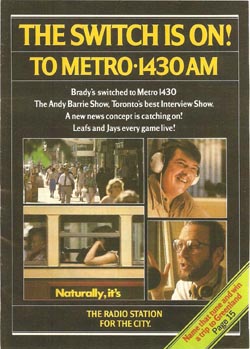
Jim Brady's 1981 move from CFTR to CJCL was big news at the time
(Description and graphic courtesy Dale Johnson)
Jim Brady was CFTR's morning man from 1973 to 1981. Brady in the Morning eventually overtook the legendary Jay Nelson at CHUM.
Brady left CFTR briefly in 1978 for a stint at KOPA Phoenix, returning two months later. His final show at CFTR the second time around was on Wednesday, August 12, 1981.
Brady left for CJCL Metro 1430, the former CKFH, where he was morning man and program director. After a couple of years there, Brady had stints in Calgary and Winnipeg. In 1990, he returned to the Toronto market at country station CFGM in 1990, just before that station CHOG with a Top 40 format. Brady later worked in Los Angeles and Ford Worth, Texas. His career began in his hometown of Toledo, Ohio, in 1964, and included a stop at CKLW Windsor/Detroit in 1968. He retired from radio in June 2008 after returning to Toledo at WRQN-FM.
We have Jim Brady's final CFTR show (the second time around). You'll also hear the voices of newscaster Mike Robbins and deejay George Hamberger, who came on each day at 10:00 a.m., right after Brady signed off with "come get me mother, I'm through!"
Hear Jim Brady's final CFTR show
(the second time around) here. ![]()
(The Dale Johnson Collection)
Talent: JIM BRADY
Station: CJCL Toronto
Date: August 21, 1981 (first show)
Time: 20:04
(Description by Dale Johnson)
After eight years as morning DJ at CFTR, Jim Brady left in 1981 to become morning DJ and program director at Metro 1430 CJCL.
The former CKFH had sunk low in the ratings, and the new owners, Telemedia, bought the station and rebranded it. The programming was a mix of information and music aimed at 25- to 49-year-olds - those too young for CFRB and CKEY, but too old for CHUM or CFTR. "We're 17th in a 16-station market," Brady said in the Toronto Star. Brady kept many of the popular features from his CFTR days, including the "who-haw it's Friday" jingles and the weather fairy.
Brady wasn't at CJCL very long, leaving in 1983. He moved to stations in Calgary and Winnipeg before returning to the Toronto market for a few months in 1990 with CFGM.
CJCL tried a variety of formats, including talk, oldies and sports. In 1995, CJCL swapped frequencies with the former CKEY, moving down to 590, and it's now all-sports, and known as The Fan 590. Meanwhile, 1430 began broadcasting multi-cultural programming under the new call letters CHKT.
This aircheck also features the voices of Mike Marshall, newscasters Glen Stone and J. Michael Philips, Pam Kioti on traffic and sportscaster Scott Ferguson.
Hear Jim Brady during
his first day on the air at Metro 1430 CJCL here. ![]()
(The Dale Johnson Collection)
Talent: BOB SIEVERS
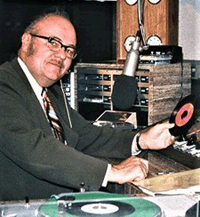
"If it is to be, it is up to me." - Bob Sievers motto
On a station with many great radio talents, there was only one "Mr. WOWO" - the beloved Bob Sievers.
Born in 1916 in Fort Wayne, Robert S. "Bob" Sievers was determined to be a radio announcer. His persistence paid off as he joined the WOWO airstaff in 1936 at age 20. It led to him hosting one of radio's longest-running radio shows, the Little Red Barn - one of North America's highest-rated wakeup shows.
Sievers was WOWO's morning voice for 48 years, ending with his retirement from full-time duties in 1984. He had several offers to move to a larger market, but turned them down to stay in his hometown. He viewed his audience as his friends and neighbours, and wasn't about to leave them. Friendly, down-to-earth both on air and in person, Sievers was listened to by 60 per cent of the Fort Wayne radio audience at one point.
Including part-time work, Sievers spent 51 years at WOWO,
minus the time he served in World War II and the Korean War. He
died September 3, 2007, and was inducted into the National Radio
Hall of Fame in 2017.
Hear Bob Sievers on WOWO (UNSCOPED) here. ![]()
Hear Bob Sievers on WOWO (SCOPED) here. ![]()
(The Joe Fazio Collection)
Talent: DAVE HULL
Station: KRLA Los Angeles
Date: October
31, 1981
Time: 54:52 (UNSCOPED)
23:13 (SCOPED)

(Courtesy Bill Dulmage)
For one glorious weekend in 1981, the 11-10 men were back
Many of the personalities that made KRLA
one of the North America's greatest Top 40 stations returned on October 31-November 1 to reprise their radio acts.Returning to the airwaves were Emperor Bob Hudson, Johnny Hayes, Casey Kasem, Ted Quillin, "The Hullabalooer" Dave Hull, and Charlie O'Donnell.
Also on hand were Dick Moreland, "The Rebel" Reb Foster, Bob Eubanks and Bobby "Boris" Pickett of "Monster Mash" fame.
Dave Hull had four tours of duty at KRLA, sandwiched around stints at five other Los Angeles stations: KFI, KMPC, KIKF, KIQQ and KHJ. The native of Alhambra, California, died on October 15, 2020 at age 86.
Hear Dave Hull on KRLA (UNSCOPED) here. ![]()
Hear Dave Hull on KRLA (SCOPED) here. ![]()
(The Joe Fazio Collection)
Talent: BOB DEARBORN
Station: Night Time America
Date: December 15, 1981
Time: 1:05:33 (unscoped)
26:11 (scoped)

Bob Dearborn tells us the story of Night Time America, the first live, daily, nationally-syndicated satellite-delivered music and call-in show in the U.S.
"The first "Night Time America"
show was on the early morning of January 2, 1981. I was hired to
be the host/producer. The network had a title for the show and
satellite time arranged but left it to me to flesh it out: decide
the format, the music, the music rotation, the features, etc. I
began with a two-year contract, at the end of which we renewed
for another two years. In September 1984 I had a meeting with
upper management about another contract renewal at the end of the
year. Because RKO had had some serious financial and legal
problems in 1984 they were unable to deliver on some promises
they earlier had said would be part of our new deal. They asked
me to think over the situation and let them know by the first of
December. When that time came, I told them I would not renew,
that I was done with it, tired and ready to move on (to radio
station ownership). My last "Night Time America" was on
New Year's Eve (actually the early morning of January 1, 1985).
But the show continued with another host for a few more months.
From what I was told, our affiliates were not too happy with the
change of hosts and the quality of the program after my
departure. Due to mass affiliate cancellations, the network ended
NTA in the spring of 1985. I'm not sure of the exact date.
The show was live from our studios in mid-town Manhattan five
nights a week, Monday through Friday (or, more correctly, Tuesday
morning through Saturday morning). Sometime in the first year we
started offering a sixth night of the program. Four nights before
the live program I would record an hour for use on Saturday
night. We would combine those four hours with an hour of "Countdown
America" which I did live on Wednesdays to make the
five-hour show for Saturday nights. This procedure continued
until our fourth year when we hired a local guy, Mike
McKay, to host the Saturday night show live. It was McKay who
took over hosting all the NTA shows after I left.
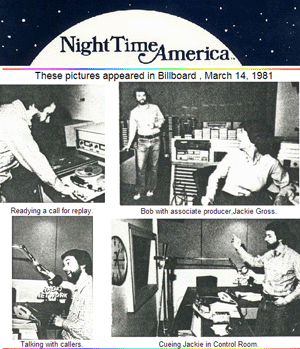
We had 154 affiliates carrying the show five hours a night, five or six nights a week for four years. And our stations were not all in small towns either. NTA aired in Chicago, Houston, Seattle, Boston, San Diego, Denver, Cincinnati, Pittsburgh, St. Louis, Salt Lake City, New Orleans, Buffalo, Portland, Raleigh ... and could be heard from West Palm Beach to Fairbanks, from Hilo to Bangor. Speaking of Fairbanks, we took NTA there in 1982 for a week of shows. It was the first time a series of radio shows heard nationally had originated in Alaska. It was also the first time TWO communications satellites were employed for broadcasts. Those were not the only firsts. The show itself was the first, live, daily, satellite-delivered music and call-in show in radio history. We were proud of that, proud to have been pioneers in satellite-delivered radio.
I always thought NTA could've been more, and if RKO hadn't run into problems and could've kept earlier promises, the show might have been greater. One of the things they had said they would was hire me another assistant. I was doing almost everything with that show: hosting, programming, music lists, affiliate schmoozing, even typing up the cart labels. I had an associate producer/engineer during the show and an engineer who during the day would cart up whatever music I needed, but other than that, I was a one-man band. It was all worth it, though, and an experience for which I'll be eternally grateful.
Hear Bob Dearborn with Night
Time America (UNSCOPED) here. ![]()
Hear Bob Dearborn with Night
Time America (SCOPED) here. ![]()
(The Tom Konard Collection/Aircheck Factory)
Talent: BRUCE
MARSHALL
Station: CJJD Hamilton
Date: 1981
Time: 4:34
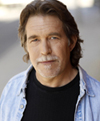
It took Bruce Marshall just seven years to reach the pinnacle of Canadian Top 40 radio.
Marshall got started in radio in 1977 at CJWA Wawa, Ontario, soon moved to CKDK Woodstock, Ontario, and by 1979 was jocking in his first major market at CJCH Halifax. After about six months in Halifax, he moved to CJJD Hamilton (now CHAM). CHUM was paying attention, as Marshall was hired in 1984 as a jock at the legendary Top 40 station. He moved across the hall to CHUM-FM in 1984 where he stayed for the next 19 years. From there Marshall went to a part-time gig at CJEZ (EZ Rock) until the Toronto station became boom 97.3, Toronto's Greatest Hits in 2009.
In addition to his 30-plus years as a broadcaster, Marshall has also been a voice performer, including serving as the image voice of TSN, and a professor in the media school of Humber College. He also worked for 18 years as a firefighter and taught in the fire service program at Seneca College and in the basic training recruit school at the Ontario Fire College. Marshall's long resume of voicing radio and TV commercials includes Tim Horton's, VW, Hyundai, the Ontario Lottery Corporation, the Western Lottery Corporation, Mazda, Symantec and Hotels.ca. He also consults on media issues and has developed several radio advertising campaigns through his company MarshallCom Group Inc.
Enjoy Bruce Marshall on CJJD here. ![]()
![]()
(The Charlie Ritenburg Collection)